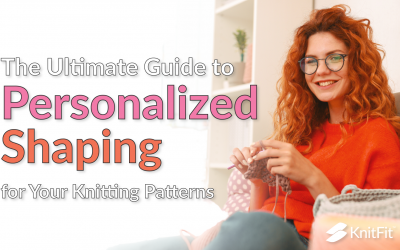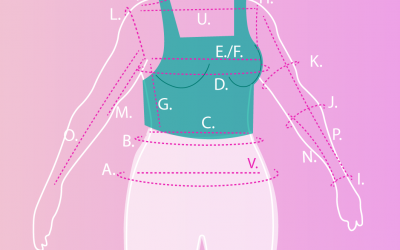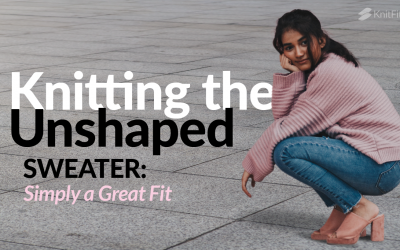Glossary
KnitFit™ offers a revolutionary approach to knitting patterns; it opens new avenues for designing garments that can be knit for the entire spectrum of the human form- not just the limited standards created in the past. Since we have this brand new approach, it’s important for us to define our terms carefully because we could be using words in ways that are slightly different from what you’re used to.
Please take a moment to review this glossary and get familiar with the terms and definitions we use on our app and website. Thank you for being a part of this exciting revolution!
A
Armhole Depth
This measurement helps determine the size and shape of a wearer’s armhole. It is a vertical distance from the shoulder to the underarm and should follow the curve from the shoulder seam. Follow this link for an image and explanation of how to take this measurement.
Armscye
Used in traditional garment tailoring, armscye is a Scottish term for the armhole. For information relevant to KnitFit custom sizing, see Armhole Depth.
B
Body
Every human has a body, and at KnitFit™, we use actual bodies to provide measurement profiles for the pattern generator. It is recommended that you measure the actual body of your wearer.
C
Circumference
A relatively circular measurement around the outside of the body bringing the tape measure back to meet itself. Examples include the chest, waist, and hip measurements.
Construction
Construction refers to how a particular garment is knit and put together. For example, a pullover can be constructed with one piece or two pieces and it could be knit from the hem to the shoulder (bottom-up), or from the shoulder to the hem (top-down).
Custom Pattern
A set of knitting instructions that has been created based on the measurements of one wearer, and the knitter’s gauge with a particular yarn and needle size.
Custom Pattern Generator
D
Design
At KnitFit™, we use the term design to describe the original design that dictates style elements of the pattern and resulting garment. However, you cannot knit a garment with a design alone- to create the actual knitting instructions, we need to create a design template, and then a knitter must generate a custom pattern using a measurement profile for the wearer and their swatch gauge (knit with a particular yarn and needle size).
Designer
The person who created and wrote the design. On KnitFit, designers have control over their intellectual property. They can set their own prices within our marketplace style shop, and the proceeds are routed directly to them.
Design Template
In order to generate custom patterns using a particular design, that design must be translated into a template on the KnitFit™ platform. Each template uses a complex series of variables to call up specific parts of our proprietary algorithm which interact with a measurement profile and gauge swatch to write a custom pattern.
Designer’s Dashboard
The module within the KnitFit™ application that designers and yarn companies use to add products, manage workflow, and track sales.
E
Ease
Ease can be set at a number larger (positive ease) or smaller (negative ease) than the body measurement. Ease can add space to a garment, but does not affect the shaping or proportions. The amount of extra fabric is meant to be distributed evenly throughout the entire garment. KnitFit™ provides a separate sleeve ease.
F
Fabric
Knitting transforms yarn into a continuous piece of cloth, which we then call fabric.
Feature
Feature can refer to the characteristics of the way a garment fits. This can include front and back shaping, shaping, ease, etc.
Features may also refer to particular technical aspects of the app or website.
Fashion
Fashion refers to popular trends in styles of dress that change over time. We at KnitFit™ believe that you, the knitter or designer, can consult current fashions for new, creative ideas but in the end we should all produce garments that suit our personal whims and comforts.
Fiber
The source of the yarn. There are many traditional and new sources of fiber from which yarns are made. Some are sourced from animals including sheep, goats, rabbits, even silk worms, etc., and others are sourced from plants, like cotton, bamboo, seaweed, and flax. Fiber content results in a variety of characteristics for the finished garment including strength, weight, softness, warmth, itch, allergies, etc. The more different fibers and weights you’re familiar with, the better you’ll be able to determine what yarns will best fit your climate, needs, and personal preferences.
Fit
The way a garment drapes over the wearer’s body. We assume well-fitted garments will have appropriate proportions, shape, and ease for each unique wearer.
Full Shaping
Full Shaping is one of three shaping options and produces a pattern that is an exacting silhouette of the wearer’s body measurements.
G
Gauge
The number of stitches and rows per 1 inch or per 10 centimeters, measured from a knitted swatch of at least 40 stitches and 40 rows. Refer to Gauge Swatching for more details on how to determine gauge for the KnitFit™ app.
Garment
A single article of clothing.
H
I
Instructions
Step-by-step directions to knit a garment.
J
K
Knitter
The person knitting the project. The creator of a knitted garment.
L
Lower Edge
This is the bottom edge, or hem, of a garment.
Local Yarn Shop (LYS)
Yarn shops that sell yarn and notions directly to knitters. These are usually local, privately-owned storefronts where owners and employees often have close personal relationships with customers.
M
Measurement
The length or circumference of a specific part of a body, expressed in either inches or centimeters.
Measurement Profile
A comprehensive list of measurements that provides size and proportion data as input to the pattern generator to create custom pattern instructions as output. A measurement profile contains the name of a wearer and date recorded. Measurement Profiles are created and stored in the Measurements module of the KnitFit™ app.
Member
An individual who has created a profile and is a user of the KnitFit™ application. This may refer to a free membership. Paid Subscribers have more access and permissions.
Modifications
Modifications are changes made to knitting instructions. This may refer to adding style features (like stripes, cables, or lace panels), altering proportions (such as adding or subtracting length to the arms or body or including bust darts), or introducing functional updates (like a button neck closure to fit over a toddler’s head).
N
No Shaping
No Shaping is one of three shaping options, and means that your pattern will not be shaped to match the wearer’s body measurements. Instead, we look at the bust, waist, and hip measurements, and create the pattern based on the largest of those 3. This gives a boxy fit that drapes over the wearer’s curves. The No Shaping option still includes body length, armhole depth, sleeve length and size, and specified ease to personalize the fit.
P
Pattern
At KnitFit™, a pattern is the specific set of instructions that a knitter uses to create a garment, calculated to include an individual wearer’s measurements, desired shaping option, ease, and the knitter’s gauge, as specified during the pattern generation process. A new pattern must be generated for every variation of the same design (different yarn, different wearer, different shaping option, different ease, etc).
Pattern Generator
This is the module in the KnitFit™ application that uses our proprietary, complex algorithms to calculate instructions specific to the measurements and gauge entered by the knitter.
Project
A project is one instance of a garment knit from a custom pattern. Each project has a pattern (in a specific design and for a specific wearer), a specific yarn in a particular color, specific needles, and a gauge swatch using that yarn and those needles. A knitter could create many different projects from a single pattern. They will all be the same design, measurement profile, shaping option, and swatch gauge. A knitter could also create many different projects from a single design with different measurement profiles, shaping options, and yarns.
Project Library
A module within the KnitFit™ app where purchased patterns are listed. The patterns are stored on the KnitFit™ server.
Patterns are organized into the following categories:
- New Patterns – designs that you have purchased, but have not generated into a custom pattern.
- Works in progress (WIPS) – projects that you have begun to knit
- Unfinished (UFOS) – patterns that you have started, but set aside
Patterns can also be moved to My Archive. The archive is meant to store patterns that are no longer on your active list. They can be accessed at any time, and moved back to the Project Library. Archive categories include:
- New patterns – Not yet generated designs
- Unfinished – Unfinished projects that you don’t plan to complete in the near term
- Completed – Projects completed and stored for future reference.
Proportion
The mathematical relationships between body measurements. For example: torso proportion takes into account the lengths between hip, waist, and underarm measurements; and arm proportion takes into account the lengths from wrist to elbow to underarm.
Q
R
S
Shaping
In knitting, shaping refers to techniques that change the structure and contours of knitted fabric so it slants and curves, usually to tailor the fit to a wearer’s body.
Shaping Options
In KnitFit™, Shaping Options are a feature that describes the extent to which the garment will follow the body measurements. Options include: No Shaping, Subtle Shaping, and Full Shaping.
Side
The side of a wearer’s body refers to an imaginary line connecting the center of the shoulder joint with the center of the hip joint. We use this line to estimate where the side seam should lay, so front and back measurements are measured from side to side.
Size-inclusive, Size inclusivity
This is a hot topic in the craft and ready-to-wear garment realms. It seems to universally mean a greater range of sizes. But that larger range still cannot address the infinite variety of sizes and proportions of real people. Without a tool like the KnitFit™ app, designers and garment producers cannot possibly solve this issue and provide true inclusivity.
Subtle Shaping
Subtle Shaping is one of three shaping options and could be described as between no shaping and full shaping. The pattern will create curves according to the wearer’s measurement profile, but they will be less dramatic.
T
U
Underarm
When measuring a wearer, the underarm is where the skin folds when the arm is relaxed at their side. The best way to find this point is to have the wearer hold a ruler or other straight, rigid object under their arm as high as comfortable, and then measure to where it comes out in front of the arm.
User
The person who is using the app. This could be a knitter, designer, or yarn company representative.
V
Variable
A variable is the name given to a value that is calculated by a program.
W
Wearer
The person who will wear the final garment. This could be the knitter themselves, someone who was gifted the sweater, or someone who has commissioned the sweater from the knitter.
X
Y
Yarn Company
The company that sells yarn, either to a LYS or direct to the knitter.
Yarn Company Representative
This is someone who works for a yarn company. They may have a variety of titles, such as Creative Director.



